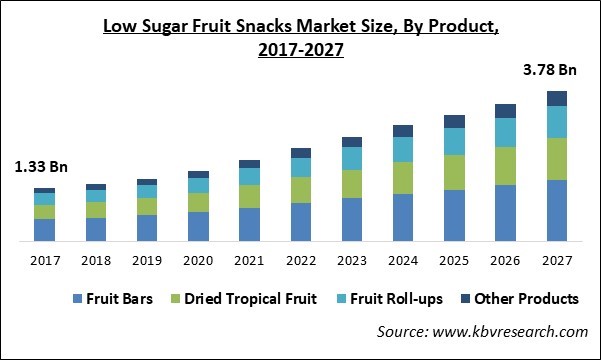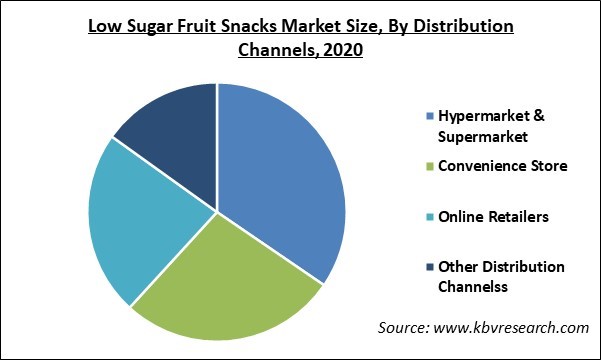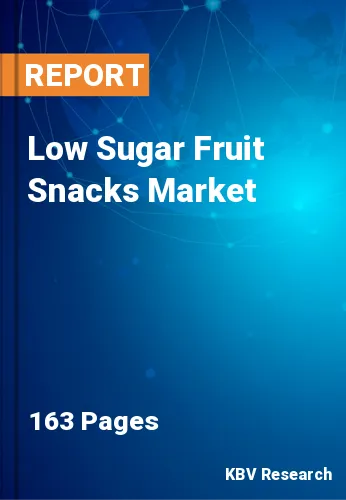The Global Low Sugar Fruit Snacks Market size is expected to reach $3,785.9 million by 2027, rising at a market growth of 10.8% CAGR during the forecast period.
Low sugar fruit snacks are processed confectionery items that contain low or zero artificial sweeteners. There is a wide variety of low sugar fruit snacks available in the market including fruit strips, fruit bars, and others. The increasing purchasing power and changing consumer preference toward ready-to-eat & healthy convenience food products would surge the demand for low sugar fruit snacks in the market.
Snacks are a crucial part of a person’s diet, which makes it important for the consumers to opt for healthy snacking. Due to this, the demand for healthier snacking alternatives such as low sugar fruit snacks would increase in the coming years. These kinds of snacks offer a wide range of health benefits for the consumers and provide numerous nutrients like potassium, fiber and others. In addition, these snacks are available in various forms, design and color that sometimes signifies the fruit used in making these products.

During the initial phase of the COVID-19 pandemic, demand and sales of snacks have witnessed a decline. It is due to the imposition of lockdown, temporary ban on manufacturing units, and disruption caused in the supply chain. Panic buying of food supplies by consumers in the initial stage of lockdown has contributed to the huge spike in the sales of ready-to-eat food in retail distribution channels. The rapid decline in the consumption of processed and packaged food products has negatively impacted the snacks industry. The high demand for gluten-free, vegetarian, and meat-free low sugar snacks options among consumers would support the growth of the low sugar fruit snacks market over the forecast period.
There is a change in the lifestyle and food patterns of consumers across the world due to their hectic schedule, which motivates them to opt for food items that require less time to consume but give more nutritional value. Snacks are a very popular meal, which offers quick satiety and a much-required break in a hectic day. With the increasing awareness among consumers to reduce the risks of chronic diseases and maintain a healthy lifestyle, the demand for various health snack options has increased in the market.
Diabetes is a chronic disease in which a person’s blood glucose, also known as blood sugar, is very high. So, doctors recommend diabetic patients eat something between their meals to stabilize their sugar level. For this, patients consider low sugar fruit snacks for their consumption as it offers high nutrition value with no artificial sugar content. Due to the increasing cases of chronic diseases, especially diabetes, companies are investing more in the development of new snack options that can well-suit their snacking requirement.
There are many challenges faced by the manufacturers including the technological and processing problems, which are estimated to hinder the growth of the low sugar fruit snacks market. It is important to manufacture these products without compromising the quality and maintaining the real essence of various fruits. In addition, fruits easily get rotten and have less shelf life, which creates a problem for the manufacturers to process them to make their products.
Based on Products, the low sugar fruit snacks market is segmented into fruit roll-ups, dried tropical fruit, fruit bars, and others. The dried tropical fruit segment is estimated to witness the fastest CAGR over the forecast period. This growth is attributed to the high popularity of tropical fruits among millennials. These dried tropical fruits are manufactured to remove any insects, damages, mold, and blemishes without adding up any preservatives or sugar.

Based on Distribution Channel the low sugar fruit snacks market is divided into online retailers, hypermarkets & supermarkets, convenience stores, and others. The online retailers segment is anticipated to display the fastest growth rate in the low sugar fruit snacks market over the forecast period. This growth is attributed to the rising penetration of smartphones and enhanced logistics infrastructure around the world. In addition, the rapid pace of digitalization across different nations would also support the growth of the segment.
| Report Attribute | Details |
|---|---|
| Market size value in 2020 | USD 1.8 Billion |
| Market size forecast in 2027 | USD 3,785.9 million |
| Base Year | 2020 |
| Historical Period | 2017 to 2019 |
| Forecast Period | 2021 to 2027 |
| Revenue Growth Rate | CAGR of 10.8% from 2021 to 2027 |
| Number of Pages | 163 |
| Number of Tables | 279 |
| Report coverage | Market Trends, Revenue Estimation and Forecast, Segmentation Analysis, Regional and Country Breakdown, Companies Strategic Developments, Company Profiling |
| Segments covered | Product, Distribution Channels, Region |
| Country scope | US, Canada, Mexico, Germany, UK, France, Russia, Spain, Italy, China, Japan, India, South Korea, Singapore, Malaysia, Brazil, Argentina, UAE, Saudi Arabia, South Africa, Nigeria |
| Growth Drivers |
|
| Restraints |
|
Based on Regions, the market is segmented into North America, Europe, Asia Pacific, and Latin America, Middle East & Africa. The low sugar fruit snacks market is analysed across North America, Europe, Asia Pacific, and LAMEA. North America emerged as the leading region in the market with the highest revenue share in 2020. The shifting preference of millennials towards low sugar food products containing high nutritional content would bolster the growth of the regional low sugar fruit snacks market.
Free Valuable Insights: Global Low Sugar Fruit Snacks Market size to reach USD 3,785.9 million by 2027
The market research report covers the analysis of key stake holders of the market. Key companies profiled in the report include PepsiCo, Inc., Nestle S.A., Danone, S.A., Ferrero Group, Calbee, Inc., Tyson Foods, Inc., Chaucer Foods Ltd. (Pilgrim Food Group PLC), Welch Foods, Inc., and WALLAROO.
By Product
By Distribution Channels
By Geography
The global low sugar fruit snacks market size is expected to reach $3,785.9 million by 2027.
Growing consumption of convenience food products are driving the market in coming years, however, Difficulties faced in processing low sugar fruit snacks limited the growth of the market.
PepsiCo, Inc., Nestle S.A., Danone, S.A., Ferrero Group, Calbee, Inc., Tyson Foods, Inc., Chaucer Foods Ltd. (Pilgrim Food Group PLC), Welch Foods, Inc., and WALLAROO.
Yes, The rapid decline in the consumption of processed and packaged food products has negatively impacted the snacks industry. The high demand for gluten-free, vegetarian, and meat-free low sugar snacks options among consumers would support the growth of the low sugar fruit snacks market over the forecast period.
The Hypermarket & Supermarket market dominated the Global Low Sugar Fruit Snacks Market by Distribution Channels in 2020, and would continue to be a dominant market till 2027; growing at a CAGR of 10.2% during the forecast period.
The North America market dominated the Global Low Sugar Fruit Snacks Market by Region in 2020, and would continue to be a dominant market till 2027; thereby, achieving a market value of $1,278.5 Million by 2027.
Our team of dedicated experts can provide you with attractive expansion opportunities for your business.

